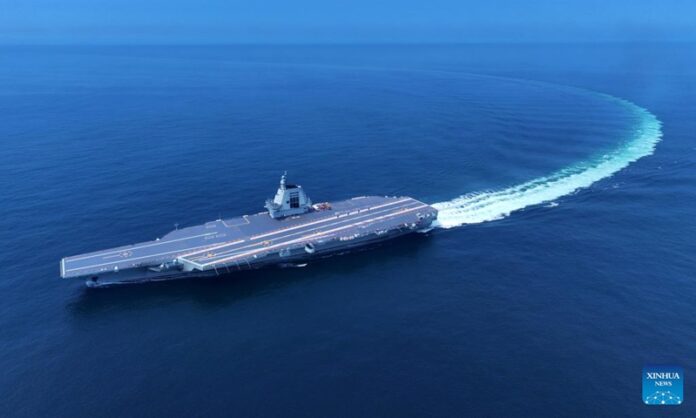BEIJING: China’s third aircraft carrier, the Fujian, on Wednesday returned to port after successfully wrapping up its eight-day maiden voyage, marking a concrete step toward the commissioning of the world-class electromagnetic catapult-equipped strategic platform, which will greatly empower the Chinese People’s Liberation Army (PLA) Navy to better safeguard peace and stability when faced with maritime and aerial security threats, experts said.
The aircraft carrier Fujian on Wednesday successfully completed its maiden test voyage which lasted for eight days and returned to a pier at Jiangnan Shipyard in Shanghai, the PLA Navy said in an announcement on the day.
During the sea trial, the Fujian completed a series of tests on its subsystems and equipment, including the propulsion and electrical systems, the PLA Navy said, stating that the voyage reached expected results.
The Fujian will continue to carry out follow-up test procedures according to preset plans, the PLA Navy said.
Fu Qianshao, a Chinese military aviation expert, told the Global Times that the first sea trial primarily tested the carrier’s capability in sailing at sea and its maneuverability.
Citing official photos and videos, observers said that the Fujian displayed its powerful propulsion and outstanding mobility by sailing at a high speed and making a sharp turn.
Another vessel could be seen in the distance when the Fujian was photographed dropping its anchor, and analysts said they might have tested the communications systems.
Fu said that the Fujian will need to test radar systems, communications systems, close-in weapons systems and landing systems in future voyage tests.
No aircraft or trails of aircraft landings could be seen on the Fujian‘s flight deck, which is normal because tests on aircraft takeoff and landing usually take place in the later stages of aircraft carrier sea trials, analysts said.
The successful maiden voyage of the Fujian came after it set sail on May 1 from Jiangnan Shipyard, where it was launched on June 17, 2022 and completed mooring tests and equipment calibrations.
Unlike its predecessors, the 60,000 ton-class Liaoning and Shandong that use ski jump ramps to assist aircraft takeoffs, the 80,000 ton-class Fujian is for the first time equipped with three electromagnetic catapults to launch aircraft.
The larger displacement allows the Fujian to carry more aircraft, and the electromagnetic catapults enable the carrier to launch aircraft more efficiently, including launching heavier aircraft, launching more types of aircraft, launching fully loaded aircraft and launching aircraft faster, experts said.
The new designs as well as the intensive use of advanced technologies, particularly the electromagnetic catapults and arresting devices, led to a relatively long mooring test period of nearly two years, and the same reasons could also cause a relatively long sea trial period, another Chinese military expert who requested anonymity told the media on Wednesday.
The successful maiden voyage has laid a solid foundation for future test voyages, and marks a concrete step toward its commissioning into the PLA Navy, the expert said. “But the PLA Navy follows scientific methods and focuses on combat capability, so it will not hurry in putting the carrier into service unless it is fully ready.”
At a time when China is facing challenging maritime and aerial security environments, and when the global security environment as a whole is deteriorating, the aircraft carrier Fujian is expected to play important roles in safeguarding national sovereignty, security, and development interests, and it will contribute to peace and stability in the region, observers said.
The Fujian‘s combat capability is significantly increased compared with the Liaoning and the Shandong, and it is considered the world’s most advanced conventionally powered aircraft carrier, experts told the media.
Thanks to the electromagnetic catapults, the Fujian is expected to host not only improved versions of the J-15 fighter jet, but also new aircraft, including the next generation stealth fighter jet J-35, the fixed wing early warning aircraft the KJ-600 and the JL-10 advanced trainer jet, according to media reports and analyses by observers.
These new aircraft, particularly the J-35 and the KJ-600, will enable the Fujian and its air wings to engage in the most high-end modern warfare, fully capable of rivaling their foreign counterparts, experts said.
Another important aspect is that with the Fujian, the PLA Navy will have three operational aircraft carriers, allowing it to have at least one always in active deployment, with the other two in training or under maintenance, experts said.
As strategic platforms, aircraft carriers will serve as a deterrence and safeguard peace and stability, observers said.
A fourth Chinese aircraft carrier will be unveiled soon and answer the question as to whether it will be nuclear-powered, the PLA Navy’s political commissar Yuan Huazhi said on the sidelines of this year’s two sessions in Beijing in answer to a media question.
Yuan refused to draw comparisons between Chinese and US aircraft carriers, stressing that China’s aircraft carrier program is not aimed at competing with the US, but at safeguarding national sovereignty, territorial integrity and rights.























